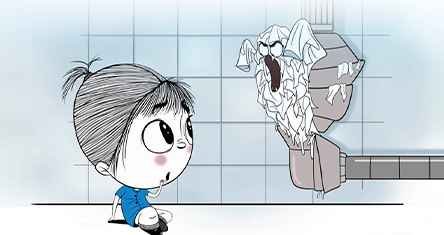Blog
DE MADRID Y DEL GRIFO
In our blog you will find tips to save water and learn how we work to convey it with the best quality to your tap in Madrid
DE MADRID Y DEL GRIFO
In our blog you will find tips to save water and learn how we work to convey it with the best quality to your tap in Madrid
FROM MADRID'S TAP

Suscríbete al blog
MONOCHLORAMINE: TERROR FOR BACTERIA
We have developed a drinking water disinfection system based on monochloramine, a compound that stays in the distribution network longer and generates fewer by-products

One of the great sanitary achievements of the 19th and 20th centuries was, without a doubt, the
disinfection of drinking water, which allowed the reduction and even eradication of not only digestive, but also skin and respiratory diseases.
Water disinfection usually takes place in the last phase of the treatment process, to ensure there are no pathogens in the distribution network. This preserves water quality all the way to the consumer’s tap.
For most water supplies in Spain, disinfection is carried out using free chlorine. This product is a
powerful disinfectant, but its residence time in the water is relatively short. It requires a management model based on numerous treatment and rechlorination plants on the network and more disinfection by-products.
But at Canal de Isabel II we have opted for a revolutionary disinfection system based on combined chlorine, and more specifically on monochloramine, a compound formed by the reaction of dissolved chlorine with ammonia. Although monochloramine is a weaker disinfectant than free chlorine, it has two major technical and economic advantages: it stays in the distribution network longer, which reduces treatment costs and leads to less formation of disinfection by-products, which has a direct impact on the health of the population being supplied. It is important to take into account that the Madrid Region has over 17,600 km’s worth of water distribution network, and we not only have to ensure that the water is disinfected at places closest to the treatment plants, but also maintain it as water is piped further away.
THE IMPORTANCE OF pH
Our use of this pioneering disinfection method was begun and is being developed thanks to the work of several of our researchers. Their research has evaluated how pH affects the percentage of
monochloramine available in the water once it has been disinfected. To observe the behaviour of
chloramine and its effectiveness as a disinfectant, we have carried out experiments with the E. coli species of coliform bacteria. This species is chosen both for its ease of handling in the laboratory and for being good an indicator of disinfection processes.
In the laboratory, we altered the pH of 5-litre samples and then inoculated with E.coli bacteria to observe the disinfectant behaviour of the chloramine. The results obtained have been revealing. Our conclusion is that the optimal range for water is between pH 8 and 8.5. These levels ensure good stability of the monochloramine, while ensuring acceptable disinfection.
The experiments have been carried out both with water from the DWTPs and with water from specific points of the Sierra Norte de Madrid network. This area has unusual features such as a low population density which leads to longer retention times of derived water, making it possible to measure the stability and disinfectant capacity of monochloramine in the distribution network.
Since we began adding monochloramine as a water disinfectant, water safety has improved in terms of health outcomes and the quality of our water. As a result of this important advance, over the last few years, we have been able to remove more than twenty rechlorination plants, which has resulted in major cost savings.
*This study has been done as part of a research project by the Lozoya-Jarama Water Treatment Area, in collaboration with the Guadarrama Treatment Area.
Suscríbete al blog
